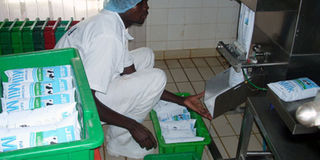Milk prices increase as demand exceeds supply

Ugandans should prepare to part with some extra money to buy a litre of milk and its products as prices shoot up due to increasing demand that has exceeded supply. Currently, raw milk prices have averagely increased by Shs100 from Shs1200 per litre in January to Shs1300 per litre at some retail outlets in central and northern Uganda.
Prices of some milk products such as yoghurt have also increased to Shs2500 from Shs2000 per 500gm. Mr Anoop Sharma, Sameer Agriculture and Livestock managing director, attributes the increase in prices to commodity scarcity caused by unfavourable climate that has reduced forages, a claim the state minister for Animal Industry Bright Rwamirama, strongly oppose.
“Raw milk supply has continued to drop because the weather is too hot. This has affected our production and limited us to meet both local and international demand for milk and its products,” said Sharma.
But according Mr Rwamirama, the country’s processing capacity of other milk products has increased thus causing a stiff demand of the commodity.
“The processing capacity has increased and we are now evacuating more milk in the country than before as processors reach distant markets,” Mr Rwamirama says. He further explains that the sector is also experiencing a gradual change as the formal sector tries to yank the milk business from the informal sector, which has dominated it for decades.
Mr Rwamirama also attributes the increase in demand to the growth in the country’s per capita milk consumption. “Uganda has had the lowest per capita milk consumption (about 50litres/person per annum) in the region. But now, it is steadily rising due to the growing middle class and the differing tastes and preferences of various dairy products,” he adds.
He said urban dairy consumption has gone up from 30 to 40 per cent due to continued encouragement by health workers for people to consume dairy products. Mr Edward Kasaija, Toro Dairy Cooperative Chairperson predicted that prices of pasteurized and UHT milk as well as other products will soon increase due to milk scarcity and the escalating cost of production.
According to Agriculture Ministry’s statistics, Uganda has about 2.5 million livestock farmers, of which 90 percent are smallholders. Although the sector has registered growth and had an impressive performance last year, experts say it is yet to meet the demand.
Total milk production by the end of 2011 stood between 1.6 billion to 1.8 billion litres, a figure which more than doubled the quantity that was produced 10 years ago. However, of all the total production, only 40 per cent is processed, 45 percent is sold unprocessed and 15 per cent is dumped.
According to a 2010 study by the Diary Development Authority, Uganda loses $23m (sh50b) annually because of milk spillage due to contamination. However, Mr Rwamirama said government is responding to the shortage by building factories and providing better breeds to farmers to stimulate production.
The minister said government with other development partners is currently constructing three factories in Kampala, Mbarara and Kiruhura districts to boost the country’s processing capacity. “We have also embarked on supporting families, practically in the eastern part of the country, with at least one good breed cow to stimulate production,” he said.
Uganda dairy products include pasteurised and powdered milk, UHT milk, cheese, yoghurt, butter, cream, ice cream and ghee.



